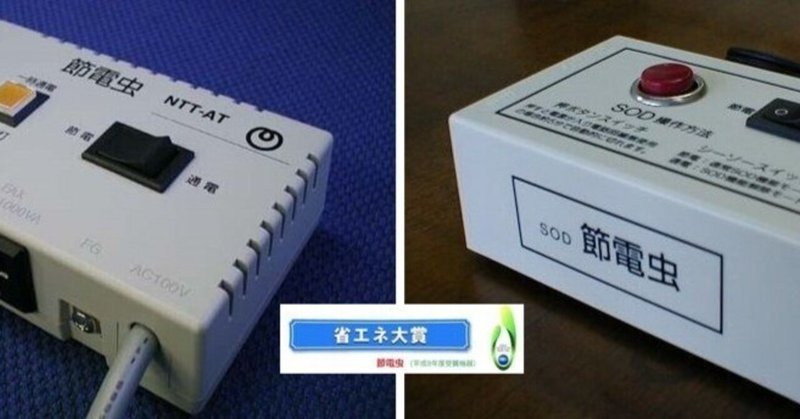
省エネ大賞受賞技術開発の軌跡 (2) Trajectory of Energy Conservation Grand Prize-winning Technology Development (2)
まえがき/Preface (2)
2002年を“私の年”と勝手に決めていた(理由は後述)私には、これは願ってもない内容の手紙でした。1994年6月の開発以来、8年近くの歳月を費やしてもなかなか認められなかった「節電虫」が市場に飛び立てるかもしれない?!のです。本当に興奮しました。
この会社は実際に付き合ってみて、社員の約30%強が博士号をもつ頭脳集団であることが分かり、改めて驚きました。
さて、この本を初めてご覧になる方の多くは“節電虫って何?”という疑問を持たれるでしょう。実は節電虫(せつでんむし、せつでんちゅう)は文字の通り、節電するための小さくて軽い道具で、私が1994年に開発しました。
そのサイズはタバコの箱3ヶ分くらいの体積と、重量が200~400グラムです。節電の対象はファクシミリを中心とした通信機器とコピー機などの待機消費電力です。
省エネルギーのことを考える時、待機消費電力は無視できません。ファクシミリやコピー機が1年に消費する電力は、それぞれ100万KWh、5800万KWhにもなります(通商産業省「産業環境ビジョン」付属資料による)。 この年間消費電力の大部分が待機時に消費する電力(待機消費電力)で占められています。もっと具体的には待機消費電力消費の占める割合はファクシミリの場合が90%、コピー機の場合が80%と推定されます。
情報化、IT(情報技術)の進化は私たちに多くの恩恵を与えてくれると同時に、機器の電源を入れたままにしますので“待ち”の電気エネルギー消費(待機消費電力消費)増大にもつながります。
もちろん、待機消費電力消費は会社や事務所の情報化機器(パソコン、ファックス、コピー機、プリンターなど)によるものだけでなく、家庭や事務所にある多くの家電商品によるものも大きいのです。家庭で常に電気コンセントに接続されている機器の約70%が待機時に微妙な電力を消費しています(待機消費電力)。その結果、一般家庭での待機消費電力量は総電力使用量の約10%にも達すると言われています。一家庭の月間電気代は平均で¥8000前後ですから、各家庭で毎月約800円、年間約9600円が待機消費電力分となります。そして、日本全体の家庭、工場、事務所での年間待機消費電力消費量は9000億円規模(推定)となり、その内の約42%、3780億円が節約可能です。(数字は2002年頃のものです。)
この本では素人である私が生活、仕事の中でふと見出した“待ち”の電気エネルギー消費(待機消費電力)をゼロにする装置「節電虫(益虫)」をどのようにして開発販売したか、そして11年の歳月を費やしてNTT-AT社から生産・販売いただけるようになったか披露します。お世話になった方々への感謝をお伝えします。ファックスとコピー機用の節電装置誕生の経緯をご紹介します。そして究極の省エネルギーである「待機消費電力ゼロ化」の技術で大手家電メーカーと肩を並べて省エネ大賞・省エネルギーセンター会長賞を含めた3つの賞を受賞した節電虫(益虫)をご紹介します。
超簡単に一枚の表で節電虫の誕生から現在までの流れをご覧になりたい方は以下のサイトにアクセスしてご覧下さい。
https://1drv.ms/b/s!Ai_aaa4f_vZzry97hG5hmjiohtaM
なお、これから連載する内容の日本語版のすべて、及び英語版の5章途中までは以下のサイトで公開しています。
日本語版:わっ! 節電虫が飛んできた! https://storys.jp/story/33913
英語版:Wow! Here comes Setsuden-mushi! https://storys.jp/story/34984
続く
Preface (2)
I had decided that the year 2002 would be "my year" (for reasons to be explained later), and this was a letter that I could not have wished for Setsuden-mushi," which had been in development since June 1994 and had not been recognized for nearly eight years, might be ready to take off to the market. I was really excited.
After actually visiting this company, I was again surprised to find out that a little over 30% of the employees are PhDs, a group of brainy people.
Now, many of you who are new to this book may be asking, "What are Setsuden-mushi?" As the name suggests, it is a small and light device for saving electricity, which I developed in 1994. (In Japanese, setsuden means power saving and mushi in this context means a small device)
Its size is about the volume of three cigarette packets and weighs 200-400 grams. The target of the power saving is the standby power consumption of communication devices, mainly facsimiles, and copy machines.
When considering energy conservation, standby power consumption cannot be ignored. Facsimiles and copy machines consume 1 million KWh and 58 million KWh of electricity per year, respectively. 58 million KWh per year (according to the "Industrial Environmental Vision" document published by the Ministry of International Trade and Industry). A large portion of this annual power consumption is accounted for by power consumed on standby (standby power consumption). More specifically, standby power consumption is estimated to account for 90% in the case of facsimiles and 80% in the case of copiers.
The evolution of information technology (IT) provides us with many benefits, but at the same time, it also leads to an increase in "standby" electrical energy consumption (standby power consumption), since equipment is left on while it is turned on.
Of course, standby power consumption is not only caused by information technology equipment (PCs, fax machines, copiers, printers, etc.) in companies and big offices, but also by many home appliances in homes and small offices. Approximately 70% of the devices and home appliances constantly connected to electrical outlets in the home consume subtle amounts of power on standby (standby power consumption). As a result, it is said that standby power consumption in the average home can reach as much as 10% of total electricity use. Since the average monthly electricity bill for a household is around ¥8,000, each household spends about ¥800 per month, or about ¥9,600 per year, on standby power consumption. Therefore, each household's monthly electricity bill is about 800 yen, or about 9,600 yen per year, for standby power consumption. The annual standby power consumption of homes, factories, and offices in Japan is estimated at 900 billion yen, of which about 42%, or 378 billion yen, can be saved. This means that about 42%, or 378 billion yen, can be saved. (These figures are from around 2002.)
This book describes how I, as a layman, found the electrical energy consumption (standby power) while "waiting time" in my daily life and work and how I developed and marketed Setsuden-mushi, a device that reduces the standby power to zero. I will show you how NTT-AT came to manufacture and sell them after 11 years of my development work. I would like to express my gratitude to those who cooperated with us. This section introduces the process of how the power-saving device for fax machines and copiers came into being. We also introduce "Setsuden-Mushi," which has won three awards, including the Energy Conservation Grand Prize and the Energy Conservation Center Chairman's Prize, along with major home appliance manufacturers, for its ultimate energy-saving technology, "zero standby power.
For your quick view of a very brief illustration of the history of "Setsuden-mushi" from its birth to the present, please visit the following website
https://1drv.ms/b/s!Ai_aaa4f_vZzrzSus-rkyG-okOzv
The Japanese version of this article and the English version up to the middle of Chapter 5 are available at the following websites.
Japanese version: https://storys.jp/story/33913
English version: https://storys.jp/story/34984
To be continued
この記事が気に入ったらサポートをしてみませんか?
